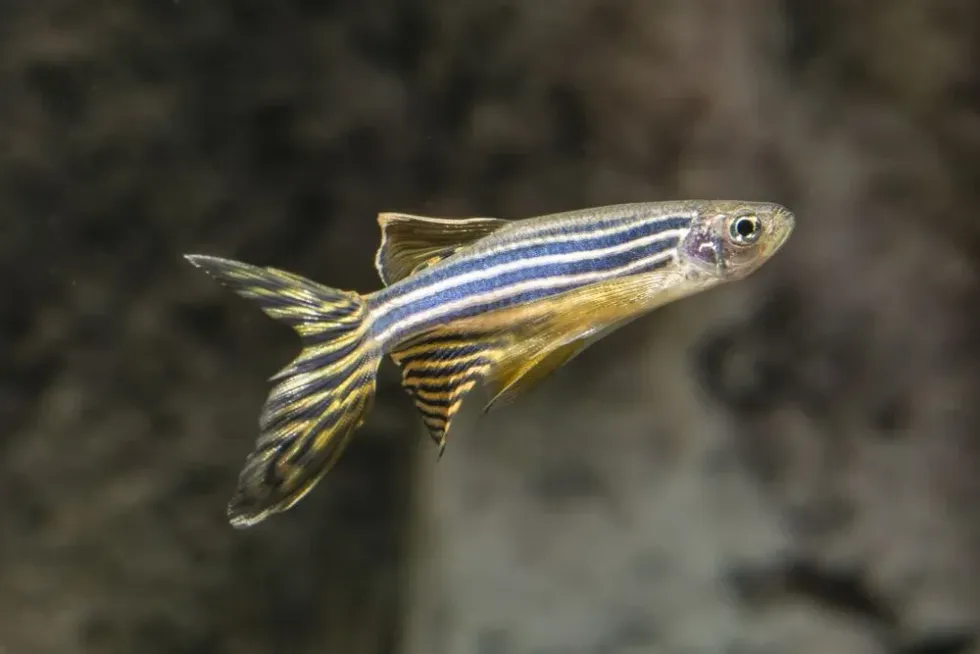Zebrafish or the Danio rerio is a freshwater schooling fish and is found primarily in India, Bangladesh, Bhutan, and Pakistan. The name danio is derived from the Bengali 'dhani' referring to any of the small various cyprinid fish.
The name danio was described in the early 19th century by Francis Hamilton. Humans and Zebra danio share 70 percent of their genes with each other. They vary in color and are about two-inch long in length as an adult and are popularly known as the striped danio.
There are a total of 27 recognized species in this genus.
A few variants of the same family include the fire ring danio, purple passion danio, longfin leopard danio, celestial danio, zebra danio fish, kyathit orange finned danio, lowlight danio, glowlight danio, celestial pearl danio, danio margaritatus, neon danio, blue danio, spotted danio, giant danio fish, rose danio, jewel danio, and gold danio among others.
The best part about keeping them as pets is that they accommodate other tank mates of fish as well including tetras, barbs, angelfish, loaches, catfish, swordtails, and plecos.
If you like this article, then please visit milkfish and porcupine fish facts.
Danio Interesting Facts
What type of animal is a danio?
Zebra danios are fish animals and tolerate a wide range of water chemistry and temperature, however they prefer freshwater bodies.
What class of animal does a danio belong to?
Zebra danio is a type of fish, it belongs to the actinopterygii class species and are considered good for beginner aquarists.
How many danios are there in the world?
As per records, the exact number of danio fish types is 27 in number. The exact number of zebra danios is not recorded but they are not under threat as of now.
Where does a danio live?
Zebra danios live in freshwater bodies and can survive in a wide range of water bodies like the ocean, river, ponds, or even lakes. They are community fishes and are best kept in a school of five or more of their own kind.
What is a danio's habitat?
Zebra danios live in a wide range of water bodies including slow-flowing rivers as well as streams. They are seen primarily in Asia and Southeast Asia. They survive in the dry season, seasonally flooded seasons as well as during the monsoon season. Their habitat primarily constitutes of silty bottomed rice paddies full of lush green vegetation.
Who do danios live with?
The zebra danio is a community fish and it's ideal to keep them in a school of five or more of their own kind. They adapt well to other species of fishes as well as long as they are not predators of the same.
Given that zebrafish requires relatively lesser space compared to other species of pet fishes danios and are accommodative in nature they make a good pet for first-time owners.
How long does a danio live?
A zebra danio lifespan is from three up to five years of age. Zebra danios age gradually and not in a sudden manner.
Zebra danio is known to have a spinal curvature and is an age-related phenotype. They need to be handled carefully since they are extremely small and sensitive beings, if you don't see any gill movements then they are deemed dead. In some instances, danio rerio could die just by being moved into a new tank if not transferred properly.
How do they reproduce?
Spawning occurs in warmer temperatures. Mating happens like with other fish species and they remain together for life.
Even if the partner dies, they don't mate with others. Pregnant zebra danio has a larger belly as compared to their male counterparts.
Zebrafish females belly balloons when it carries danio eggs. When she is ready to lay eggs her midsection bulges in circular protrusions. The ideal temperature for the same is 78 F. One female zebrafish lays close to 100 eggs and other females too lay eggs in and about the same time.
About 300-500 eggs are scattered across the bottom and on the plants. Once this happens it's essential to ensure that adult fishe males and females are transferred into another tank as they have the possibility of eating their own fry.
Danio fry hatches in two days. If the eggs have fallen onto the glass part of the aquarium you simply need to scrape them off and do it carefully to ensure all eggs are out properly.
What is their conservation status?
The danio rerio is considered the Least Concern (not threatened) species by the International Union For Conservation Of Nature (IUCN).
Danio Fun Facts
What do danios look like?
Danios are schooling fish hence you would likely see them in schools. They come in various colors, and a good way to identify them is to look at their size, adult fishes are usually two-inch long and a few like the giant danios and dangila are five-inch long and are long-finned.
They usually have a stripped body and in some instances light patterns and color.
Since they are constant movers they tend to appear different in color however they don't change color. Also, they are able to see in the dark.
How cute are they?
Zebrafish are extremely cute and tiny fishes and a great companion to first-time owners who are willing to adopt fishes as pets. Zebrafish are accommodative and love to move around.
It's best to adopt five or more at one time instead of adopting just one of the species since it will make them lonely as compared to keeping them in a community aquarium.
How do they communicate?
Fishes don't communicate verbally however they make use of silent forms of communications including body language and other communications through vibrations and signs. For example, zebrafish are fast swimmers and often tend to follow or chase other of the same species this is not unnatural, however if it reaches a stage of nipping then it's another issue.
Zebrafish also interact with other species of fish in the aquarium if there are any.
How big is a danio?
Long fin danio or the zebra danio size is 5cm (2inch) which is ten times bigger than the smallest fish in the world the paedocypris who is 7.9mm in length.
How fast can a danio swim?
Scientific records state that zebrafish danio's fishes swim quickly and are small fishes that require more space to move around. They exist in both slow-moving streams as well as fast-flowing ones and are easily adaptable and accommodative to most conditions.
How much does a danio weigh?
Zebrafish danio size is small and each danio types weigh different however long-finned zebra danio weighs 6.4mm-21.3mm which is 3.5-213.4mg.
What are their male and female names of the species?
Male and female of the longfin danio are not addressed by different names but have certain differences physically which help identify them. Females are usually larger in size as compared to males.
Males on the other hand are slender in proportion. Males appear more torpedo-shaped and females tend to have a relatively larger belly. During breeding season, the female's belly grows up to the size of a balloon in most instances.
What would you call a baby danio?
Zebra danio eggs are extremely small in size, once they hatch a baby fish is referred to as a fry until they grow up. Including shrimp in their diet is a good choice to help them get the essential nutrients they need to grow.
As a fry, they are extremely small in size and can start to eat shrimp after ten days of hatching. The young fry needs to be fed egglayer fish food twice a day.
What do they eat?
Danio fishes live with other mates and travel in schools and are primarily omnivores. Their diet consists of tropical granules, shrimp pellets, and color flakes.
Since they are seen primarily in tanks as pets they should be fed food along with other tankmates to avoid any trouble and confusion. They also tend to feed on eggs and hence it's essential to keep them away from their own fry as well post-birth.
Are they aggressive?
Both zebrafish males and females are equally amazing pets to keep for first-time owners given that they are small in size however, they can get aggressive in certain instances specifically towards slow-moving long-finned species. This is because they are innately fast swimmers and in a need to remove the long-finned species they are seen frequently biting at their fins.
Would they make a good pet?
Giant danio care is simple as long as their dietary requirements are taken care of and their environment is safe and clean for them to survive in.
They are adaptable to most conditions and make an excellent pet for first-time pet owners. Even if you already own fishes you could consider including these fishes if you have the adequate space to make your aquarium more vibrant and appealing.
Ensure to check if celestial danio temperature will match your existing aquarium and if it will get along with other species of fish in your aquarium.
Did you know...
Using red light in an aquarium at night is useful to observe the fish at night. The fish cannot distinguish the difference between the color red and others and it also doesn't affect their sleeping patterns.
Fishes lack the part of the brain, the cerebral cortex, so they do not cry or express sorrow as humans do. An added reason for the same is the fact that they are constantly surrounded by water hence their eyes are bathed in a watery medium at all times.
The danio kyathit is closely related to the zebra danio species of fish and is a fairly uncommon fish species that is native to Myanmar. Other species of the same family like the glofish danio require a heater to keep them healthy and active to make them feel like they are in their natural environment.
Danio glofish is native to the river basins of South America.
If aquariums are chemically treated then danio's immediately die and also other factors like changing tanks can lead to a loss in their populations since they get stressed out easily.
What is the difference between wild danios and danios in captivity?
The wild counterparts of these fish often do not reach the same length as those raised in aquariums. Secondly, if danios are held in captivity they tend to live only two to three years, this is also due to a change in habitat and other factors as well.
Wild danios are found near the bottom of the waterbody while danios in captivity are found on top of the aquarium.
How have danios helped science?
These little fish have even helped scientists in the study and treatment of various cancers, by helping them design models to characterize human diseases. Apart from this, danios zebra danio has also been a useful model for studies of vertebrate development.
Biologists consider it to be a special animal because zebra danio has a rather transparent body as compared to other fish species.
Striped danio is a unique and beautiful species of fish that have contributed greatly to science and are also great pets for first-time owners. If you are considering adopting a fish consider adopting a school.
Here at Kidadl, we have carefully created lots of interesting family-friendly animal facts for everyone to discover! Learn more about some other fish including herring, or codfish.
You can even occupy yourself at home by drawing one on our goldfish coloring pages.










